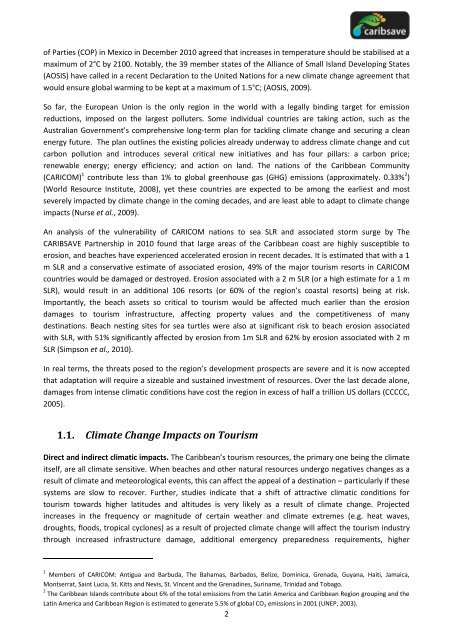THE CARIBSAVE CLIMATE CHANGE RISK ATLAS
THE CARIBSAVE CLIMATE CHANGE RISK ATLAS
THE CARIBSAVE CLIMATE CHANGE RISK ATLAS
You also want an ePaper? Increase the reach of your titles
YUMPU automatically turns print PDFs into web optimized ePapers that Google loves.
of Parties (COP) in Mexico in December 2010 agreed that increases in temperature should be stabilised at a<br />
maximum of 2°C by 2100. Notably, the 39 member states of the Alliance of Small Island Developing States<br />
(AOSIS) have called in a recent Declaration to the United Nations for a new climate change agreement that<br />
would ensure global warming to be kept at a maximum of 1.5°C; (AOSIS, 2009).<br />
So far, the European Union is the only region in the world with a legally binding target for emission<br />
reductions, imposed on the largest polluters. Some individual countries are taking action, such as the<br />
Australian Government’s comprehensive long-term plan for tackling climate change and securing a clean<br />
energy future. The plan outlines the existing policies already underway to address climate change and cut<br />
carbon pollution and introduces several critical new initiatives and has four pillars: a carbon price;<br />
renewable energy; energy efficiency; and action on land. The nations of the Caribbean Community<br />
(CARICOM) 1 contribute less than 1% to global greenhouse gas (GHG) emissions (approximately. 0.33% 2 )<br />
(World Resource Institute, 2008), yet these countries are expected to be among the earliest and most<br />
severely impacted by climate change in the coming decades, and are least able to adapt to climate change<br />
impacts (Nurse et al., 2009).<br />
An analysis of the vulnerability of CARICOM nations to sea SLR and associated storm surge by The<br />
<strong>CARIBSAVE</strong> Partnership in 2010 found that large areas of the Caribbean coast are highly susceptible to<br />
erosion, and beaches have experienced accelerated erosion in recent decades. It is estimated that with a 1<br />
m SLR and a conservative estimate of associated erosion, 49% of the major tourism resorts in CARICOM<br />
countries would be damaged or destroyed. Erosion associated with a 2 m SLR (or a high estimate for a 1 m<br />
SLR), would result in an additional 106 resorts (or 60% of the region’s coastal resorts) being at risk.<br />
Importantly, the beach assets so critical to tourism would be affected much earlier than the erosion<br />
damages to tourism infrastructure, affecting property values and the competitiveness of many<br />
destinations. Beach nesting sites for sea turtles were also at significant risk to beach erosion associated<br />
with SLR, with 51% significantly affected by erosion from 1m SLR and 62% by erosion associated with 2 m<br />
SLR (Simpson et al., 2010).<br />
In real terms, the threats posed to the region’s development prospects are severe and it is now accepted<br />
that adaptation will require a sizeable and sustained investment of resources. Over the last decade alone,<br />
damages from intense climatic conditions have cost the region in excess of half a trillion US dollars (CCCCC,<br />
2005).<br />
1.1. Climate Change Impacts on Tourism<br />
Direct and indirect climatic impacts. The Caribbean’s tourism resources, the primary one being the climate<br />
itself, are all climate sensitive. When beaches and other natural resources undergo negatives changes as a<br />
result of climate and meteorological events, this can affect the appeal of a destination – particularly if these<br />
systems are slow to recover. Further, studies indicate that a shift of attractive climatic conditions for<br />
tourism towards higher latitudes and altitudes is very likely as a result of climate change. Projected<br />
increases in the frequency or magnitude of certain weather and climate extremes (e.g. heat waves,<br />
droughts, floods, tropical cyclones) as a result of projected climate change will affect the tourism industry<br />
through increased infrastructure damage, additional emergency preparedness requirements, higher<br />
1<br />
Members of CARICOM: Antigua and Barbuda, The Bahamas, Barbados, Belize, Dominica, Grenada, Guyana, Haiti, Jamaica,<br />
Montserrat, Saint Lucia, St. Kitts and Nevis, St. Vincent and the Grenadines, Suriname, Trinidad and Tobago.<br />
2<br />
The Caribbean Islands contribute about 6% of the total emissions from the Latin America and Caribbean Region grouping and the<br />
Latin America and Caribbean Region is estimated to generate 5.5% of global CO 2 emissions in 2001 (UNEP, 2003).<br />
2





